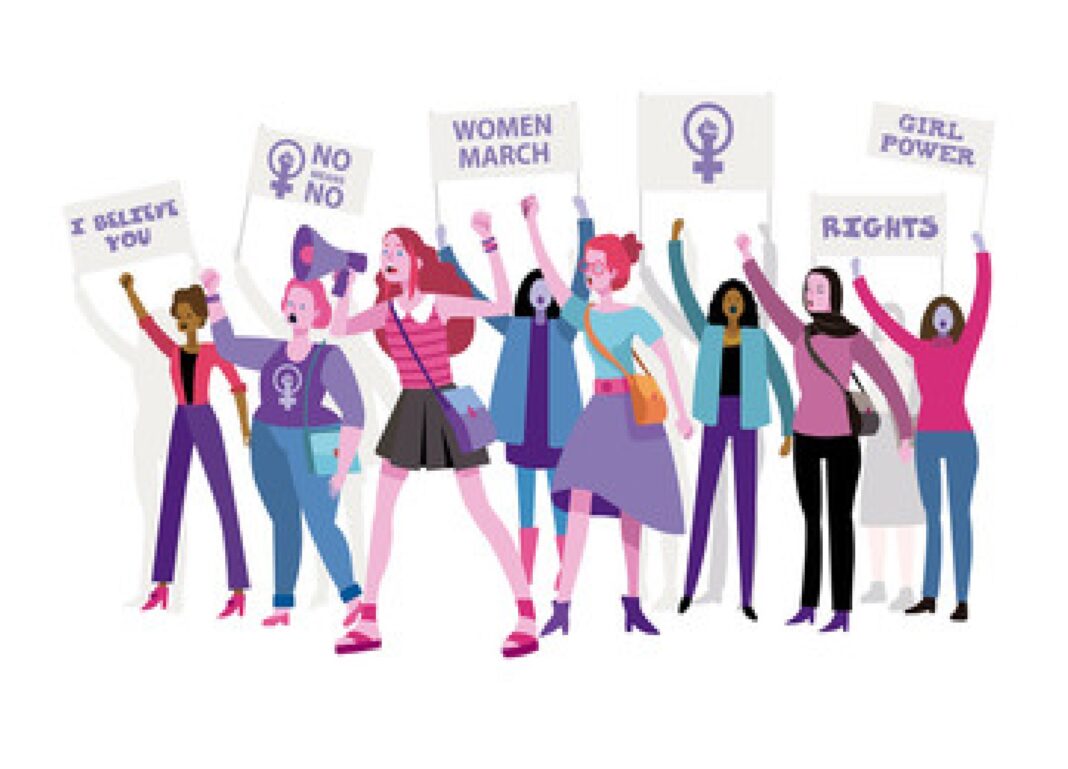“A form of dynamic, pluralistic behavior which progressively develops structure through time, and aims at partial or complete modification of the social order.” This is how Anderson and Parker defined a social movement as. Simply put, a social movement is an endeavor by an association to bring about a positive transformation in the society. A social movement may also be aimed at resisting a change. Some movements are intended for modifying certain facets of the existing social order whereas others may seek to change it completely.
There has been n-number of movements to date, nationally as well as globally, where people have tried to bring change to the society we inhabit. One such movement which took the world by storm and that needs a particular mention is the Feminist movement. The term feminism can be used to illustrate a political, cultural, social, or economic movement aimed at ascertaining equal rights and legal protection for women. Feminism entails political and sociological philosophies and theories regarding the issues of gender difference, moreover, it’s a movement that campaigns for gender equality for women and advocates women’s rights and interests. Although the terms such as “feminism” or “feminist” did not gain extensive use until the 1970s, they were already being used in the public phraseology since much earlier; for example, Katherine Hepburn articulates of the “feminist movement” in the 1942 film Woman of the Year.
In Western countries, the feminist movement is observed to prevail in three waves, beginning in the 19th and the early 20th century. The first wave of the feminist movement began in the United Kingdom and the United States. Originally this wave of feminism focused on the endorsement of equal contract and property rights for women, something which was till then missing, and the opposition to chattel marriage and sense of ownership and possession of married women and their children by their husbands. Nevertheless, by the end of the nineteenth century, this activism started focusing primarily on gaining political power, predominantly the right of women’s enfranchisement. The first wave of feminism is thought to have ended in America when the Nineteenth Amendment to the United States Constitution in 1919 saw the light of the day, which granted women the right to vote in all the states. The first wave of the feminist movement was chiefly led by the white women in the middle class; it took the second wave of feminism for the women of color to develop their voice.
The period between the early 1960s to the late 1980s is thought to be the duration for the second wave of the feminist movement. This movement at the outset was concentrated in the United States of America but slowly stretched to reach the other Western countries. This second wave concentrated more on public and private injustices. Issues such as reproductive rights, rape, domestic violence, and safety at the workplace became the highlights of the movement. There was widespread effort to transform the inferior image of women to a more positive and realistic one.
The third wave of this movement began in the early 90s mainly coming up as a perceived response for the failures of the second wave. What’s central to the third wave’s ideology is the post-structuralist interpretation of gender and sexuality. The third wave feminism did not come as a mere reaction but was a movement in itself because the feminist causes had much work ahead. New currents and theories like transfeminism, sex positivity, and post-modern feminism saw its emergence during this period. The rights and programs that were gained during the second wave movement, acted as a foundation for the third wave movement.
Though the feminist movement was raging on in the western countries, its eastern counterparts, like India, saw this movement at a much later phase and in a different format. During the early Vedic times, we find evidence of women holding a strong position in the Indian society. But that phase slowly declined and the passage of time threw the women of India out of the limelight and confined them to their homes. Later our entry into the arena of modernity was mediated through colonialism.
In the 19th century, after being influence by the liberal democratic values from the West, the male social reformers, in agreement with the British administrators, kicked off the process of fighting against various issues. Female infanticide, sati, prostitution, were among the various issues that came to the forefront. When the first generation of English educated empowered women came into existence, they became the torchbearers of the women’s movement in the pre-independence era. Many of them directed their energies in structuring pioneer women’s organizations such as the National Federation for Indian Women, Young Women Christian Association, All India Women’s Conference, Anjuman-e-Islam, among others.
The All India Women’s Conference fought for issues like gaining voting rights for women, against child marriage and supported the cause of skill development in women. The Young Women Christian Association became the source of providing vocational training to women. But the feminist movement in India was different with respect to its western counterparts as this movement had to work under the caste and religious framework. In India, a rise in perception about the subjugation of women and their societal status was entwined with a desire to break away from the discrimination carried out by the British. The non-violent movements under Mahatma Gandhi then saw a large number of women participation and slowly the women were incorporated into the political scenery. While one thing common between the feminist movements in the West and India was that both fought for the ultimate goal of equality, but the problems they dealt with and the hindrances they faced were vastly distinct.
The Emergency Rule in India coincided with the declaration from the United Nations, to celebrate the year 1975 as an International Women’s Year. By the year 1977, almost two years later when the Emergency was lifted, numerous groups, spearheaded by women and talking about democratic rights issues, had come into existence. After being gagged for nearly two years the press finally found its voice resulting in the open documentation of atrocities committed against women during the Emergency period. These acts of cruelty resonated with most women’s own experience of life whether be it in the family, in the workplace, or in the streets. The zenith of the anger was reached in the year 1980 when many women’s groups came out of their shells to protest. For the first time, the topic of women’s oppression was not only confined to the seminars and discussion forums but also sparked interest in the media. Women got a platform to voice their issues and this brought among the women a collective identity with was constantly missing.
Greater access to education, the right to set off divorce proceedings, more equitable pay with men, and the right to own property these things may have sounded surreal to the women living in the 18th or even the 19th century. It would have been tough for them to imagine this, not because it was wrong but because it wasn’t believed possible due to the skewed power game played onto them. With the ushering of the era of the feminist moment, the position of women improved in society manifolds.
The feminist movement has come a long way, spanning years of protests, campaigns, and laws, the graph has been on the upward trend, and still finds immense relevance in the present time. The issues of the movement have changed down the line but the essence of the fight remains the same. We still live in a society that’s termed as patriarchal and if such a society exists, the movement will continue to go on. The society cannot run on biased and distorted ideologies; equality and respect for everyone needs to be achieved. The feminist movement had a great impact on generations of women as it taught them to speak up and demand the rightful place in society.
Nowadays we see girls with pass percentage higher than the boys, we see women as pilots, presidents, judges and so much more, something which was unimaginable before. This is the gift of the years of the feminist movement and the relentless pursuit of equality. This world has come a long way while holding hands with the feminist movement but still has a long way to go. Feminism, as a movement is misconstrued to be a women’s movement; it is a movement that concerns itself with liberation from society imposed constraints and equality for both men and women. This movement is still relevant in the present day scenario because stereotypes about gender roles still exist in society, women are still judged on the basis of what the wear and how they carry themselves. Sexual harassment still exists even inside a marriage. Many issues have been solved but many still remain and that’s why this movement still finds its relevance among people, especially with the “fairer” sex.












